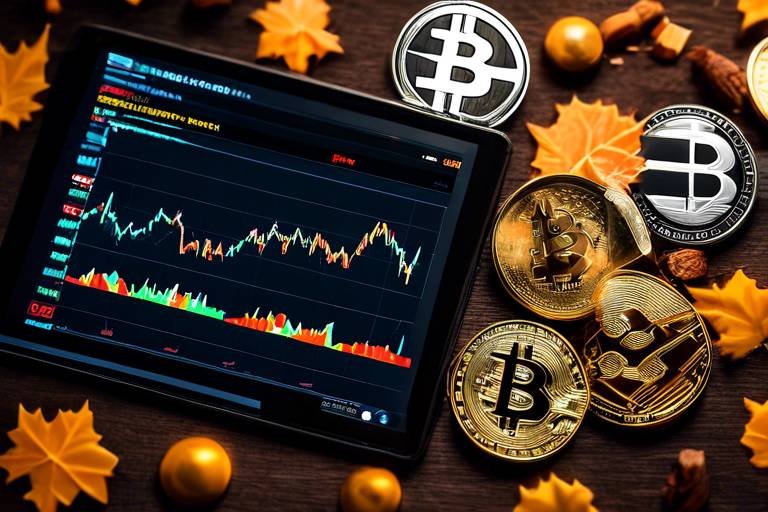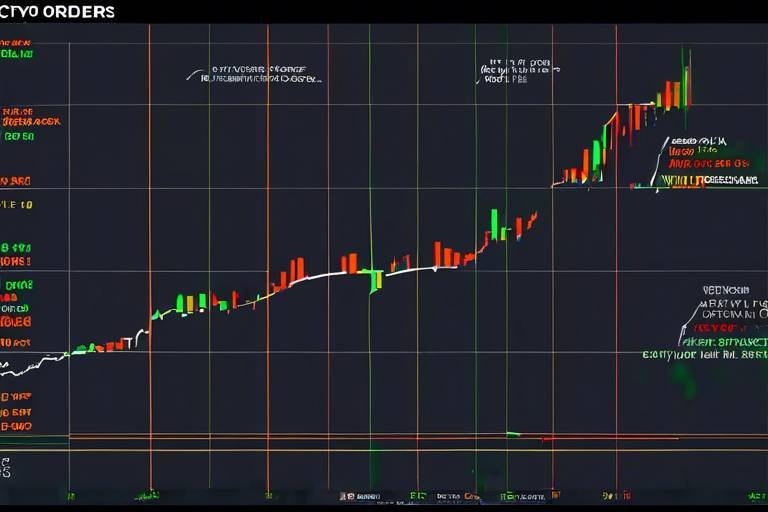Seasonal Trends in Cryptocurrency Trading
This article explores the various seasonal trends that impact cryptocurrency trading, examining how market behaviors shift throughout the year and the factors influencing these changes. Understanding these trends can be the difference between a successful trade and a costly mistake. So, let’s dive into the fascinating world of cryptocurrency trading and uncover the secrets that the seasons hold!
Seasonal trends refer to recurring patterns in market behavior that can be observed over specific periods. Just like the changing seasons affect our daily lives, they also influence the trading landscape. Recognizing these trends can help traders make informed decisions based on historical data. By analyzing past market behaviors, traders can anticipate potential price movements, allowing them to strategize effectively. Imagine being able to predict a storm before it hits; that’s the power of understanding seasonal trends in cryptocurrency.
Analyzing historical price patterns reveals how cryptocurrencies have performed during different seasons. For instance, looking back at previous years, we can identify significant trends and price movements that have occurred. This historical perspective is like having a map to guide you through the unpredictable terrain of cryptocurrency trading. In the table below, we summarize some key trends observed in the past few years:
| Season | Price Movement | Key Influencing Factors |
|---|---|---|
| Winter | Increased Volatility | Holidays, Year-End Adjustments |
| Spring | Price Recovery | Market Optimism, New Investments |
| Summer | Lower Volatility | Trading Volume Decrease |
| Fall | Market Correction | Profit-Taking, Investor Sentiment |
The winter months often bring increased volatility in cryptocurrency markets. This volatility can be attributed to various factors, including holiday trading and year-end financial adjustments. As traders prepare for the new year, they often adjust their portfolios, leading to significant price swings. Think of it as the market's own version of spring cleaning, where traders are tidying up their investments. This creates a unique opportunity for those willing to navigate the choppy waters.
Holidays can significantly influence trading volumes and market sentiment. For example, during the festive season, many traders may take time off, leading to decreased trading activity. However, this can also result in unexpected price movements as fewer participants can lead to larger swings. It's essential to understand how these holiday periods affect trader behavior, as they can create both risks and opportunities. Imagine a quiet street during a holiday; it’s peaceful, but any sudden movement stands out dramatically.
As the year closes, traders may engage in tax-loss harvesting, impacting market prices. This financial strategy involves selling underperforming assets to offset gains, which can create noticeable seasonal trends. Understanding these tax implications is crucial for traders looking to make informed decisions. It’s like a game of chess, where every move can influence the outcome of the match. By being aware of these strategies, traders can position themselves advantageously.
Spring often sees a recovery in cryptocurrency prices after the winter volatility. This seasonal rebound can be attributed to a renewed sense of optimism among traders and investors. As the weather warms up, so does the market sentiment. New investments often flow in during this time, creating a fertile ground for price growth. Traders can expect a more stable environment, making it an ideal time to position themselves for potential gains.
Summer months can present unique trading opportunities due to lower volatility and trading volume. Many traders take vacations, leading to a quieter market. This environment can be a double-edged sword; while it may be less chaotic, it also means that significant price movements can occur with less trading volume. Developing effective strategies for navigating the summer market landscape is essential. Traders should focus on maintaining a balanced approach, keeping an eye on major developments while avoiding overreacting to minor fluctuations.
Understanding market sentiment during the summer months is essential for traders. Sentiment can shift dramatically, influenced by various factors such as news events, regulatory changes, and even global economic conditions. Traders should always be attuned to these shifts, as they can significantly impact trading decisions. It's akin to reading the wind before setting sail; knowing which way it's blowing can help you navigate your journey more effectively.
Summer often hosts various cryptocurrency events and conferences, influencing market trends. These gatherings can serve as a catalyst for new ideas, partnerships, and investments, all of which can affect trading activity. Keeping an eye on these events can provide traders with valuable insights into market movements. Just as a festival brings people together, these conferences can stir excitement and momentum in the cryptocurrency space.
- What are seasonal trends in cryptocurrency trading? Seasonal trends are recurring patterns in market behavior that can be observed over specific periods, influencing trading decisions.
- How do holidays affect cryptocurrency trading? Holidays can lead to decreased trading volumes and increased volatility, impacting market sentiment and price movements.
- What strategies can I use during summer trading? Focus on maintaining a balanced approach, stay informed about market sentiment, and keep an eye on major events that could influence trading.

Understanding Seasonal Trends
Seasonal trends in cryptocurrency trading are fascinating phenomena that can greatly influence a trader's strategy and outcomes. Essentially, these trends refer to the recurring patterns in market behavior that emerge during specific times of the year. Just like how the seasons affect our clothing choices or vacation plans, they also have a profound impact on how traders buy, sell, and hold cryptocurrencies. By recognizing these trends, traders can make more informed decisions based on historical data, which can lead to better financial outcomes.
To grasp the essence of seasonal trends, it's crucial to consider the various factors that drive these changes. For instance, market sentiment often fluctuates with the seasons, influenced by external events such as holidays, regulatory announcements, and even social media trends. A trader who understands these seasonal shifts can anticipate potential market movements and adjust their strategies accordingly. It’s akin to a surfer waiting for the perfect wave; timing is everything!
Moreover, analyzing historical data can reveal significant trends that have occurred in previous years. For example, many traders notice that certain months tend to exhibit bullish or bearish behavior, often linked to investor psychology and broader economic conditions. By studying these patterns, traders can create a more robust trading plan. Below is a simple table summarizing common seasonal trends observed in cryptocurrency markets:
| Season | Common Trends | Market Sentiment |
|---|---|---|
| Winter | Increased volatility, potential sell-offs | Bearish due to year-end adjustments |
| Spring | Price recovery, bullish sentiment | Optimistic as new investments pour in |
| Summer | Lower trading volume, unique opportunities | Mixed; often quieter trading |
| Fall | Potential for rallies, market corrections | Speculative and cautious |
Understanding these seasonal trends isn't just about numbers and charts; it's about reading the market's mood and anticipating how other traders will react. Are they going to panic sell during a market dip, or are they going to buy the dip, hoping for a rebound? The answers to these questions can often be found in the seasonal patterns that have emerged over the years.
In conclusion, recognizing seasonal trends in cryptocurrency trading is akin to having a secret weapon in your trading arsenal. It allows traders to navigate the unpredictable waters of the crypto market with greater confidence and precision. So, whether you're a seasoned trader or just starting, keeping an eye on these trends can make all the difference in your trading journey!

Historical Price Patterns
When it comes to understanding the cryptocurrency market, play a pivotal role. By analyzing how cryptocurrencies have behaved during various seasons, traders can gain valuable insights into potential future movements. Over the years, certain trends have emerged, revealing how market dynamics shift with the changing seasons. For instance, many traders have observed that prices often experience a significant uptick during the spring months, following the winter's volatility. This phenomenon can be attributed to a combination of factors, including renewed investor interest and the overall market sentiment shifting towards optimism.
To illustrate this, let’s take a look at some key historical price movements of popular cryptocurrencies like Bitcoin and Ethereum over the past few years:
| Year | Winter Price (Dec) | Spring Price (Apr) | Change (%) |
|---|---|---|---|
| 2020 | $29,000 | $63,000 | 117% |
| 2021 | $42,000 | $55,000 | 31% |
| 2022 | $47,000 | $39,000 | -17% |
| 2023 | $16,000 | $30,000 | 88% |
As shown in the table, the price fluctuations during these seasons can be quite dramatic. In 2020, for instance, Bitcoin surged over 117% from December to April, showcasing the potential for significant gains during the spring recovery period. However, it’s essential to note that not every year follows this trend. For instance, in 2022, Bitcoin experienced a decline of 17% from winter to spring, highlighting the unpredictable nature of the cryptocurrency market.
Moreover, the impact of external factors cannot be overlooked. Events such as regulatory changes, technological advancements, and macroeconomic conditions all contribute to shaping these historical patterns. For example, the rise of institutional investment in cryptocurrencies has added a new layer of complexity to market behavior. As more traditional investors enter the space, their trading patterns can significantly influence price movements, often leading to increased volatility during the winter months.
In conclusion, while historical price patterns provide a roadmap for traders, it’s crucial to remain vigilant and adaptable. The cryptocurrency market is notoriously fickle, and what worked in the past may not necessarily hold true in the future. By continuously monitoring market conditions and being aware of seasonal trends, traders can position themselves to make informed decisions that capitalize on these recurring patterns.

Winter Volatility
Winter months are often a whirlwind in the cryptocurrency market, characterized by heightened volatility that can leave even seasoned traders on the edge of their seats. As the temperature drops, so do the barriers to entry for many new traders, leading to increased trading activity. But what exactly drives this volatility? One major factor is the holiday season, which typically sees a spike in trading volumes as people buy and sell digital assets, either as gifts or as investments. This surge can create erratic price movements that may seem unpredictable at first glance.
Moreover, the end of the year brings about a unique set of financial strategies, particularly tax-related decisions that can heavily influence market behavior. Traders often engage in tax-loss harvesting—a strategy where they sell off losing investments to offset gains elsewhere. This practice isn't just a minor blip on the radar; it can significantly impact market prices as large volumes of assets are traded in a short period.
To illustrate the impact of winter volatility, let’s take a look at some key statistics from previous winters:
| Year | Average Price Change (%) | Trading Volume (in billions) |
|---|---|---|
| 2020 | +25% | 15.5 |
| 2021 | -30% | 20.1 |
| 2022 | +15% | 12.3 |
As shown in the table above, the average price change during winter months can be quite dramatic, ranging from significant gains to steep losses. This volatility can be attributed not only to holiday trading but also to market sentiment that often fluctuates with the changing seasons. Traders must stay alert during this time, as sudden price swings can present both risks and opportunities.
Additionally, it’s essential to consider how broader economic factors play into this winter volatility. For instance, global economic conditions, regulatory news, and technological advancements can all create ripples in the market. Keeping an eye on these external influences can help traders make more informed decisions and prepare for potential price shifts.
In conclusion, winter volatility is a complex interplay of seasonal trends, trader behavior, and external factors. Understanding these dynamics can empower traders to navigate the tumultuous waters of the cryptocurrency market more effectively. So, as you bundle up this winter, remember that while the weather may be cold, the cryptocurrency market can be even chillier—especially for those unprepared for its unpredictable nature.
- What causes winter volatility in cryptocurrency trading?
Winter volatility is primarily driven by holiday trading, year-end financial strategies, and broader economic factors that influence market sentiment. - How can traders prepare for winter volatility?
Traders can prepare by staying informed about market trends, utilizing risk management strategies, and being aware of external economic influences. - Is winter a good time to invest in cryptocurrencies?
Winter can present both risks and opportunities; it’s crucial to analyze market conditions and historical trends before making investment decisions.

Impact of Holidays
The impact of holidays on cryptocurrency trading is a fascinating phenomenon that traders should not overlook. During holiday seasons, the market often experiences fluctuations that can be both predictable and surprising. For instance, major holidays such as Christmas and New Year tend to witness a surge in trading activity, as many investors are looking to capitalize on year-end gains or adjust their portfolios. This increased trading volume can lead to heightened volatility, making it essential for traders to stay alert and informed.
Moreover, the sentiment surrounding holidays can significantly influence trader behavior. When the festive spirit is in the air, many individuals feel more optimistic about their investments, leading to a collective buying frenzy. This can push prices up, creating a bullish trend that may last well into the new year. Conversely, after the holiday cheer subsides, traders may engage in profit-taking, resulting in a bearish market correction. Understanding these psychological aspects of trading during holidays can help traders anticipate potential price movements.
One interesting aspect to consider is how different cultures celebrate holidays. For example, while Western markets might see increased activity during Christmas, Asian markets may experience similar trends during the Lunar New Year. This cultural variance can create unique trading opportunities, as traders can exploit the differences in market behavior across regions. To illustrate this point, here’s a simple table showing the correlation between major holidays and trading volume shifts:
| Holiday | Region | Typical Trading Volume Change |
|---|---|---|
| Christmas | Western Markets | +20% |
| Lunar New Year | Asian Markets | +15% |
| Thanksgiving | North America | -10% |
| Diwali | India | +25% |
As the table indicates, holidays can lead to significant changes in trading volumes, which can be leveraged by savvy traders. It’s also worth noting that the impact of holidays extends beyond just the trading volume; they can also affect the overall market sentiment. For instance, during the holiday season, traders might be more inclined to hold onto their assets rather than sell, anticipating a price increase as the new year approaches.
In summary, the impact of holidays on cryptocurrency trading is multifaceted and can create both opportunities and challenges. By understanding the behavioral patterns associated with different holidays, traders can better navigate the market landscape and make more informed decisions. So, whether you’re celebrating with family or trading from the comfort of your home, keep an eye on those holiday trends—they might just be the key to your next successful trade!

Year-End Tax Considerations
As the calendar year draws to a close, traders in the cryptocurrency market often find themselves navigating a complex landscape of tax implications that can significantly influence their trading strategies. One of the most common practices during this period is tax-loss harvesting. This is where traders sell off underperforming assets to offset gains made on profitable trades, thereby minimizing their overall tax liability. It’s akin to cleaning out your closet before the new year; you want to make space for the new while getting rid of what no longer serves you.
But why does this matter for the cryptocurrency market? Well, when a large number of traders engage in tax-loss harvesting, it can lead to increased selling pressure on certain assets, which may cause prices to dip. This seasonal trend is particularly noticeable in December, as traders rush to finalize their financial strategies before the year-end. If you’re not paying attention, you might miss out on some significant price movements that could affect your portfolio.
Moreover, understanding the tax implications of your trades is crucial. For instance, in many jurisdictions, cryptocurrencies are treated as property rather than currency, meaning each trade could trigger a taxable event. This can lead to a complicated web of accounting, especially if you’ve engaged in multiple trades throughout the year. Keeping track of your gains and losses is essential, and utilizing tools or software designed for cryptocurrency tax reporting can save you a lot of headaches come tax season.
Additionally, it’s important to note that different countries have varying regulations regarding cryptocurrency taxation. For example, in the United States, the IRS requires that all cryptocurrency transactions be reported, and failure to do so can lead to penalties. Traders should be aware of their local laws and regulations to avoid any unexpected surprises.
In summary, year-end tax considerations are a double-edged sword for cryptocurrency traders. While they can provide opportunities to optimize tax liabilities, they can also create volatility in the market that savvy traders must navigate. As we approach the end of the year, being proactive and informed about how your trading decisions impact your taxes can make a significant difference in your financial outcomes.
- What is tax-loss harvesting? Tax-loss harvesting is the practice of selling securities at a loss to offset taxes on gains from other investments.
- How do cryptocurrency taxes work? Cryptocurrencies are generally treated as property for tax purposes, meaning that each trade can trigger a capital gain or loss.
- Do I need to report every cryptocurrency transaction? Yes, in many jurisdictions, all transactions involving cryptocurrency need to be reported for tax purposes.
- What tools can help with cryptocurrency tax reporting? There are various software tools available that can help track and report cryptocurrency transactions effectively.

Spring Recovery Trends
As the chill of winter begins to fade, the cryptocurrency market often experiences a noticeable rebound during the spring months. This seasonal recovery is not just a coincidence; it’s a complex interplay of market psychology, investor behavior, and external factors that can significantly influence trading patterns. After the heightened volatility and uncertainty of winter, traders typically look for signs of stability and growth, creating a fertile ground for price increases.
One of the key drivers of this spring recovery is the renewed investor optimism. As tax season wraps up and traders have settled their financial affairs, many are ready to reinvest their profits or allocate new funds into the market. This influx of capital can lead to increased demand for cryptocurrencies, pushing prices upward. Additionally, the warmer weather often brings a more positive sentiment, encouraging more people to engage in trading activities. It’s almost as if the market mirrors the natural world, blooming and thriving as the seasons change.
Moreover, the spring months are often marked by significant technological advancements and project launches within the cryptocurrency space. Many blockchain projects aim to unveil new features or updates in the spring, coinciding with conferences and events that generate buzz and excitement among investors. For instance, major announcements or upgrades can lead to increased trading volumes, as traders rush to capitalize on the potential for price appreciation. This cyclical nature of innovation and investment creates a dynamic environment that can lead to substantial gains.
In addition to these factors, the spring season often sees a shift in trading strategies. Traders may begin to adopt more bullish positions as they perceive the market to be recovering. This shift can be reflected in the trading volume, where more buy orders flood the market, further driving prices up. However, it's essential for traders to remain cautious and aware of potential pitfalls, as the excitement can sometimes lead to overexuberance and subsequent corrections.
To illustrate the importance of these spring recovery trends, let's take a look at historical performance data. The table below summarizes the average price changes of major cryptocurrencies during the spring months over the past few years:
| Year | Bitcoin (BTC) | Ethereum (ETH) | Litecoin (LTC) |
|---|---|---|---|
| 2020 | +35% | +45% | +30% |
| 2021 | +50% | +60% | +40% |
| 2022 | +20% | +30% | +25% |
| 2023 | +55% | +70% | +50% |
This data underscores the significant potential for growth during the spring months, reinforcing the notion that traders should be vigilant and prepared to seize opportunities as they arise. As we move deeper into the spring, keeping an eye on market trends and external factors will be crucial for anyone looking to navigate this vibrant season successfully.
- What causes the spring recovery in cryptocurrency prices?
The spring recovery is largely driven by renewed investor optimism, increased capital inflow, and significant technological advancements within the cryptocurrency space. - How can traders capitalize on spring trends?
Traders can capitalize on spring trends by closely monitoring market sentiment, participating in relevant events, and adjusting their trading strategies to align with the bullish market conditions. - Are there risks associated with spring trading?
Yes, while spring often brings positive trends, traders should remain cautious of market corrections and overexuberance, which can lead to sudden price drops.

Summer Trading Strategies
As the sun shines brighter and the days stretch longer, the cryptocurrency market often takes on a different rhythm during the summer months. This period can be a double-edged sword for traders: on one hand, the lower trading volumes can lead to less volatility, making it an ideal time for strategic investments; on the other hand, the seasonal lull means that price movements can be less predictable. So, how can traders navigate this unique landscape? Let's dive into some effective summer trading strategies that can help you make the most of this season.
One of the key strategies during summer is to focus on technical analysis. With fewer traders in the market, price movements may not be as influenced by news or sentiment as they are during busier periods. This makes it essential to rely on charts and indicators to identify potential entry and exit points. For instance, using moving averages can help you spot trends that may not be immediately apparent. Additionally, traders often find success with range trading, where they identify price levels that cryptocurrencies tend to bounce between, allowing for profitable trades within those ranges.
Moreover, summer is a fantastic time to engage in long-term investments. With the market typically quieter, it can be an excellent opportunity to accumulate assets at lower prices. Many seasoned traders adopt a “buy and hold” strategy during this time, especially for projects they believe in for the long haul. By focusing on fundamental analysis—evaluating the technology, team, and market potential of a cryptocurrency—you can make informed decisions that pay off when the market heats up again in the fall.
Another aspect to consider is the impact of market sentiment during the summer. It's essential to stay informed about any upcoming events, such as major conferences or product launches, as these can significantly influence market behavior. For example, if a well-known cryptocurrency project is hosting a summer conference, it could attract attention and investment, leading to price surges. Staying connected with the community through social media and forums can provide valuable insights into the prevailing sentiment.
Finally, don’t overlook the importance of risk management. Even in a quieter market, unexpected events can lead to sudden price fluctuations. Setting stop-loss orders can help protect your investments from significant downturns. Additionally, diversifying your portfolio can mitigate risks associated with any single asset. Consider allocating a portion of your investments into stablecoins or other less volatile assets to balance out your exposure.
In summary, summer trading strategies revolve around a mix of technical analysis, long-term investment, understanding market sentiment, and robust risk management. By adopting these strategies, you can position yourself to capitalize on the unique opportunities that summer brings to the cryptocurrency market. So, grab your shades and get ready to ride the waves of summer trading!
- What is the best strategy for trading cryptocurrencies in the summer?
The best strategy often involves a combination of technical analysis, long-term investments, and staying informed about market sentiment and events.
- How can I manage risk while trading in the summer?
Utilizing stop-loss orders and diversifying your portfolio can help manage risk effectively, even in a quieter market.
- Are there any specific events to watch for during the summer?
Yes, major cryptocurrency conferences and product launches can significantly influence market behavior and should be monitored closely.

Market Sentiment in Summer
When we think of summer, we often imagine sunshine, vacations, and a more relaxed pace of life. But what about the world of cryptocurrency trading? Interestingly, summer can bring a unique market sentiment that traders need to pay attention to. Unlike the frantic trading seen in other seasons, summer often experiences a dip in trading volume, primarily due to many traders taking time off to enjoy the sunny weather. This leads to a less volatile market, which can be both a blessing and a curse.
During the summer months, the overall sentiment tends to shift. With fewer participants in the market, price movements can become more pronounced, leading to opportunities for savvy traders. However, this also means that the market can be easily swayed by news events or social media trends. For instance, a single tweet from a well-known influencer can send prices soaring or crashing, making it vital for traders to stay alert even when the market seems quieter.
Another factor influencing summer sentiment is the psychological aspect of trading. Many traders might assume that the summer months are a time to relax, leading to a general feeling of complacency. This can create an environment where prices stabilize or even decline, as enthusiasm wanes. However, for those who are willing to dig deeper, summer can also present a golden opportunity to buy into dips and position themselves for a potential autumn rally.
Additionally, summer often sees a rise in speculative trading, where traders might take on more risk in hopes of capturing quick gains. This can lead to fluctuations that are not necessarily tied to the underlying fundamentals of the cryptocurrencies. For those looking to navigate this landscape, understanding the psychology of fellow traders can be just as important as analyzing market data.
To summarize, summer market sentiment is characterized by:
- Lower trading volumes due to vacations
- Increased susceptibility to news and social media
- Potential for speculative trading
- Opportunities for buying on dips
As you prepare for summer trading, keep these factors in mind. The key is to remain vigilant and adaptable, taking advantage of the unique market dynamics that this season brings. By doing so, you can turn the typically quieter summer months into a profitable trading experience.
Q: Why do trading volumes decrease in the summer?
A: Many traders take vacations during the summer months, leading to lower participation in the market.
Q: How can I take advantage of summer trading opportunities?
A: Look for price dips and remain attentive to news events, as summer can lead to quick price movements.
Q: Is summer a good time to invest in cryptocurrencies?
A: It can be, especially if you identify undervalued assets during quieter trading periods. Just ensure to do thorough research!

Seasonal Events and Conferences
This article explores the various seasonal trends that impact cryptocurrency trading, examining how market behaviors shift throughout the year and the factors influencing these changes.
Seasonal trends refer to recurring patterns in market behavior that can be observed over specific periods. Recognizing these trends can help traders make informed decisions based on historical data.
Analyzing historical price patterns reveals how cryptocurrencies have performed during different seasons. This section highlights significant trends and price movements that have occurred in previous years.
Winter months often bring increased volatility in cryptocurrency markets. This volatility can be attributed to various factors, including holiday trading and year-end financial adjustments.
Holidays can significantly influence trading volumes and market sentiment. Understanding how holiday periods affect trader behavior is crucial for anticipating price movements.
As the year closes, traders may engage in tax-loss harvesting, impacting market prices. This section discusses how these financial strategies can create seasonal trends.
Spring often sees a recovery in cryptocurrency prices after winter volatility. This section examines the factors contributing to this seasonal rebound and what traders can expect.
Summer months can present unique trading opportunities due to lower volatility and trading volume. This section explores effective strategies for navigating the summer market landscape.
Understanding market sentiment during the summer months is essential for traders. This subheading discusses how sentiment shifts and impacts trading decisions.
When it comes to the world of cryptocurrency, summer is not just about sun and fun; it's also a bustling time for that can significantly influence market trends. Events like blockchain conferences, meetups, and expos serve as platforms where enthusiasts, investors, and developers gather to share knowledge, network, and showcase innovations. The excitement and buzz generated during these events can lead to increased trading activity, as new ideas and projects are unveiled, capturing the attention of traders and investors alike.
For instance, major conferences such as Consensus and Devcon often attract thousands of participants and can create a ripple effect in the market. Traders often anticipate announcements and trends that arise from these gatherings, leading to a surge in trading volumes. The impact of these events can be felt not just during the conferences themselves but also in the weeks and months that follow, as new projects gain traction and investor interest grows.
Moreover, summer events can also foster a sense of community and collaboration among traders. The exchange of ideas and strategies during these gatherings can lead to innovative trading approaches and a better understanding of market dynamics. As traders share insights and experiences, they may adjust their strategies based on the collective knowledge gained from these interactions.
To illustrate the significance of these events, let's take a look at a table summarizing some of the notable cryptocurrency conferences held during the summer months:
| Event Name | Date | Location | Key Focus |
|---|---|---|---|
| Consensus | June 2023 | New York, USA | Blockchain Innovations |
| Devcon | August 2023 | Lisbon, Portugal | Ethereum Development |
| Blockchain Expo | July 2023 | London, UK | Industry Applications |
As you can see, these conferences not only serve as learning opportunities but also as catalysts for market movements. Traders who stay informed about these events can better position themselves to capitalize on potential price changes that may arise as a result of the insights and announcements made during these gatherings.
- What are seasonal trends in cryptocurrency trading?
Seasonal trends are recurring patterns in market behavior observed during specific times of the year, which can help traders make informed decisions. - How do holidays affect cryptocurrency trading?
Holidays can lead to changes in trading volumes and market sentiment, impacting price movements as traders adjust their strategies. - What role do conferences play in cryptocurrency trading?
Conferences create networking opportunities and generate excitement around new projects, which can lead to increased trading activity and market shifts.
Frequently Asked Questions
- What are seasonal trends in cryptocurrency trading?
Seasonal trends in cryptocurrency trading refer to recurring patterns in market behavior that occur during specific times of the year. Understanding these trends can help traders make informed decisions by analyzing historical data and recognizing how market dynamics shift with the seasons.
- How do winter months affect cryptocurrency prices?
Winter months often bring increased volatility in cryptocurrency markets. Factors such as holiday trading and year-end financial adjustments can lead to significant price fluctuations. Traders should be aware of these dynamics to navigate the market effectively during this period.
- What impact do holidays have on cryptocurrency trading?
Holidays can significantly influence trading volumes and market sentiment. During holiday periods, traders may behave differently, leading to changes in price movements. Understanding these patterns can help traders anticipate market shifts and adjust their strategies accordingly.
- How does year-end tax consideration affect trading?
As the year wraps up, many traders engage in tax-loss harvesting, which can impact market prices. This financial strategy often leads to increased selling activity, creating seasonal trends that traders should be mindful of when planning their trades.
- What are spring recovery trends in cryptocurrency?
Spring often sees a recovery in cryptocurrency prices after the volatility of winter. This seasonal rebound can be attributed to various factors, including renewed investor interest and positive market sentiment as traders look to capitalize on lower prices from the previous months.
- How can traders navigate the summer months effectively?
Summer months can present unique trading opportunities due to generally lower volatility and trading volume. Traders can adopt specific strategies, such as focusing on long-term investments or monitoring market sentiment, to make the most of this period.
- What role does market sentiment play in summer trading?
Market sentiment during the summer months can shift significantly, impacting trading decisions. Traders should keep an eye on news and events that may influence sentiment, as this can lead to unexpected price movements and opportunities.
- Are there any key events that influence summer trading?
Yes, summer often hosts various cryptocurrency events and conferences that can influence market trends. These events can attract attention and investment, potentially leading to increased trading activity and price movements, making it essential for traders to stay informed.



















